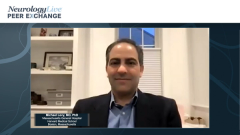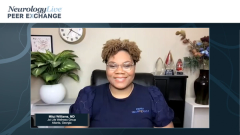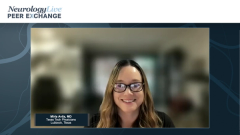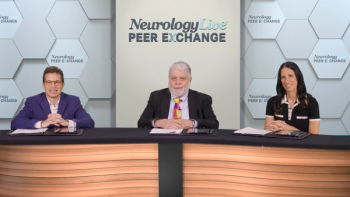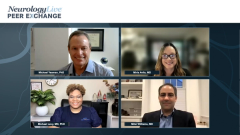
Psychosomatic Presentations of NMOSD
Drs Michael Levy, Mirla Avila, Mitzi Williams, and Michael Yeaman assess atypical presentations of NMOSD and the importance of building trust in a patient-provider relationship.
Episodes in this series

Michael Yeaman, PhD: Presentation can differ considerably among different population groups, with optic neuritis and transverse myelitis being most predominant, and combinations of presentations as well as less common area postrema, brain, or brain stem conditions that might manifest as cognitive or other disorders that aren’t high on the list of the differential with respect to NMOSD [neuromyelitis optica spectrum disorder]. Michael, in your experience, what are the types of presentations that might be considered psychosomatic or likely non-NMOSD?
Michael Levy, MD, PhD: There are some very strange presentations of NMO [neuromyelitis optica] that trigger the feeling from ED [emergency department] doctors that it isn’t real. We’ve had NMO attacks that present with nausea, vomiting, and hiccups. For an ED doctor who’s looking for a GI [gastrointestinal] cause, NMO is usually the last thing on their list to look for. Similarly, I had a patient who had narcolepsy. This person couldn’t stay awake for more than 2 minutes at a time, and the ED doctors wanted to dismiss that person as being overly tired or using a drug or medication that caused sleepiness. But no, these were strange NMO attacks. We even had a young man in prison who presented with a drop in his body temperature that ended up being fatal and unrecognized because this is a very strange but possible presentation with NMO.
Michael Yeaman, PhD: Very interesting. Mirla, can you share your experience in unusual presentations in your population of patients?
Mirla Avila, MD: Yes. I had a patient with diabetes who was about 52 years old when she presented. It started with nausea and vomiting, so she was seen by internal medicine and a GI doctor. She had exploratory abdominal surgery. Of course, it was all normal, so she was dismissed and sent home with a PICC [peripherally inserted central catheter] line. About 2 weeks later, when she was home, she started noticing numbness in her arm where the PICC line was. She thought that it was related to the PICC line and not moving her arm until she developed transverse myelitis. That’s when she was readmitted to the hospital and neurology was consulted. As Michael said, this is a good example of presenting with nausea and vomiting and [doctors] immediately thinking it’s something GI related. Because she had diabetes, they thought gastroparesis or an obstruction before they considered NMOSD.
Michael Yeaman, PhD: Thanks a lot, Mirla. Mitzi, you mentioned earlier that there can be a lack of believability in patients who present. I wanted to get your sense of the trust-building process in the patient and health care provider relationship and how that might differ among different populations in your patient cohort.
Mitzi Williams, MD: Absolutely. Certainly, if you look historically at a community like the Black or African American community in the United States, there are many injustices and things that have occurred in terms of unethical research and poor interactions with the medical system. Some of these things are historic. People don’t remember some of them. Younger generations might not remember the Tuskegee experiment or Henrietta Lacks, but there are things that are passed down through those families, including suspicions about the medical system.
Another important thing is that people [continue to] experience discrimination. These aren’t just historic experiences. There are times when people will be evaluated and they may be told to go home because there’s nothing wrong with them, or people will flat-out tell them there’s nothing wrong with them, or they’ll be called psychosomatic or diagnosed as having a psychiatric illness when they have some other illness.
The important thing for us as health care providers is to try to do as reasonable a work-up as possible. Certainly, we can’t do every test on every person, but there often has to be that suspicion that there’s something wrong to make you dig a little deeper. I’ve seen countless stories since the [COVID-19] pandemic where a person presented with something very atypical and their doctor said, “I knew something was wrong, so I kept digging until I found the thing.” You have to do that with these patients to make sure we’re doing the appropriate work-up. If someone comes in with something like severe vomiting, don’t dismiss that. Try to make sure that we’re doing the appropriate work-up and referring them to the appropriate specialist to try to get to the bottom of it.
Michael Yeaman, PhD: Excellent points, Mitzi. Michael, maybe we could ask for your suggestions about trust building, particularly with these complex diseases that require a lot of investment of time and effort to solve.
Michael Levy, MD, PhD: It’s incumbent on the physician to build that trust. If patients don’t trust you right away, it’s easy to dismiss them and let them go somewhere else, but it isn’t in their best interest, your best interest, or the field’s best interest. These patients can contribute. They can contribute to clinical trials and to other patients who need support in your community. It’s in everyone’s best interest to establish this trust. One of the best ways to do that are patient days, educational events where you invite patients from all over to meet, socialize, and network. The caregivers learn from other caregivers, and the patients learn from other patients. They share secrets and strategies. It builds trust in the community and in the physician community.
Michael Yeaman, PhD: Well said, Michael.
Transcript edited for clarity
Newsletter
Keep your finger on the pulse of neurology—subscribe to NeurologyLive for expert interviews, new data, and breakthrough treatment updates.

